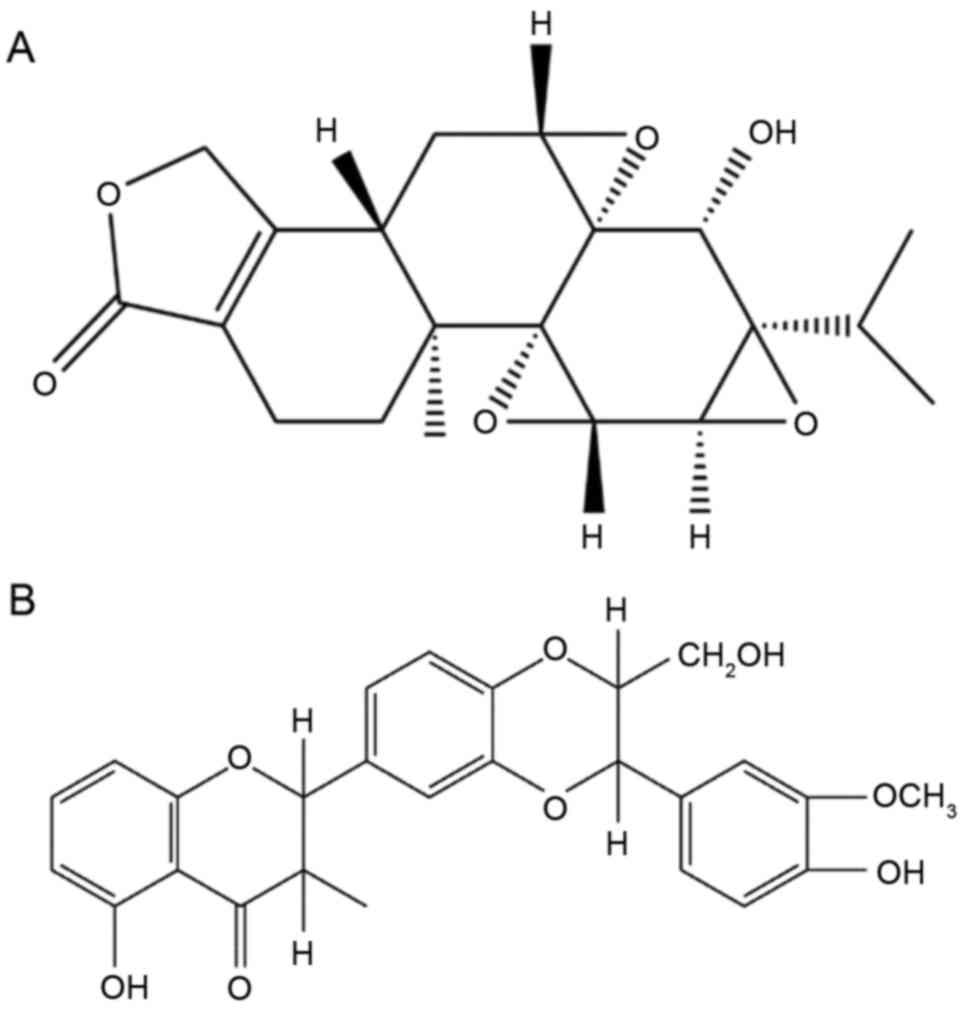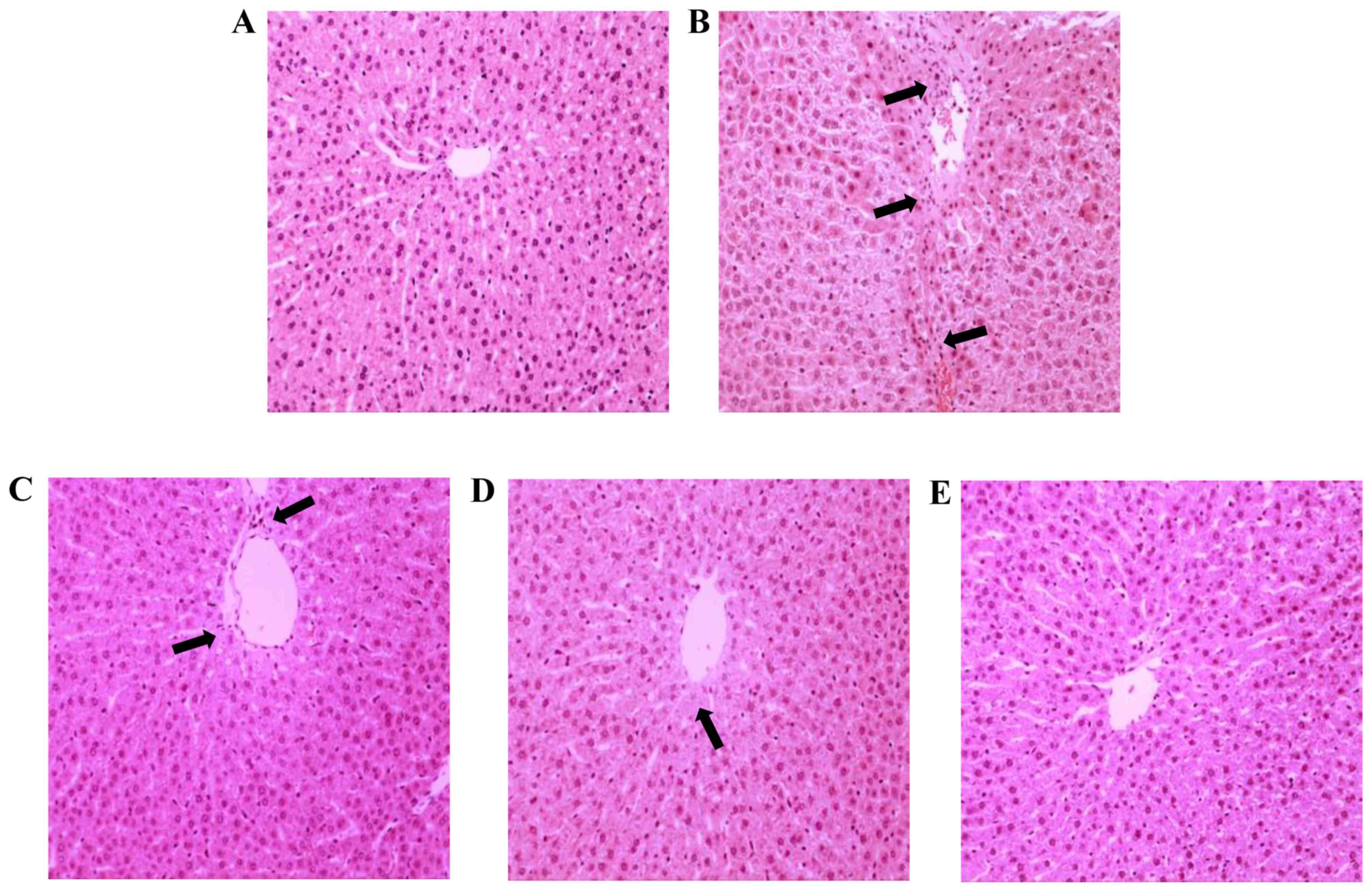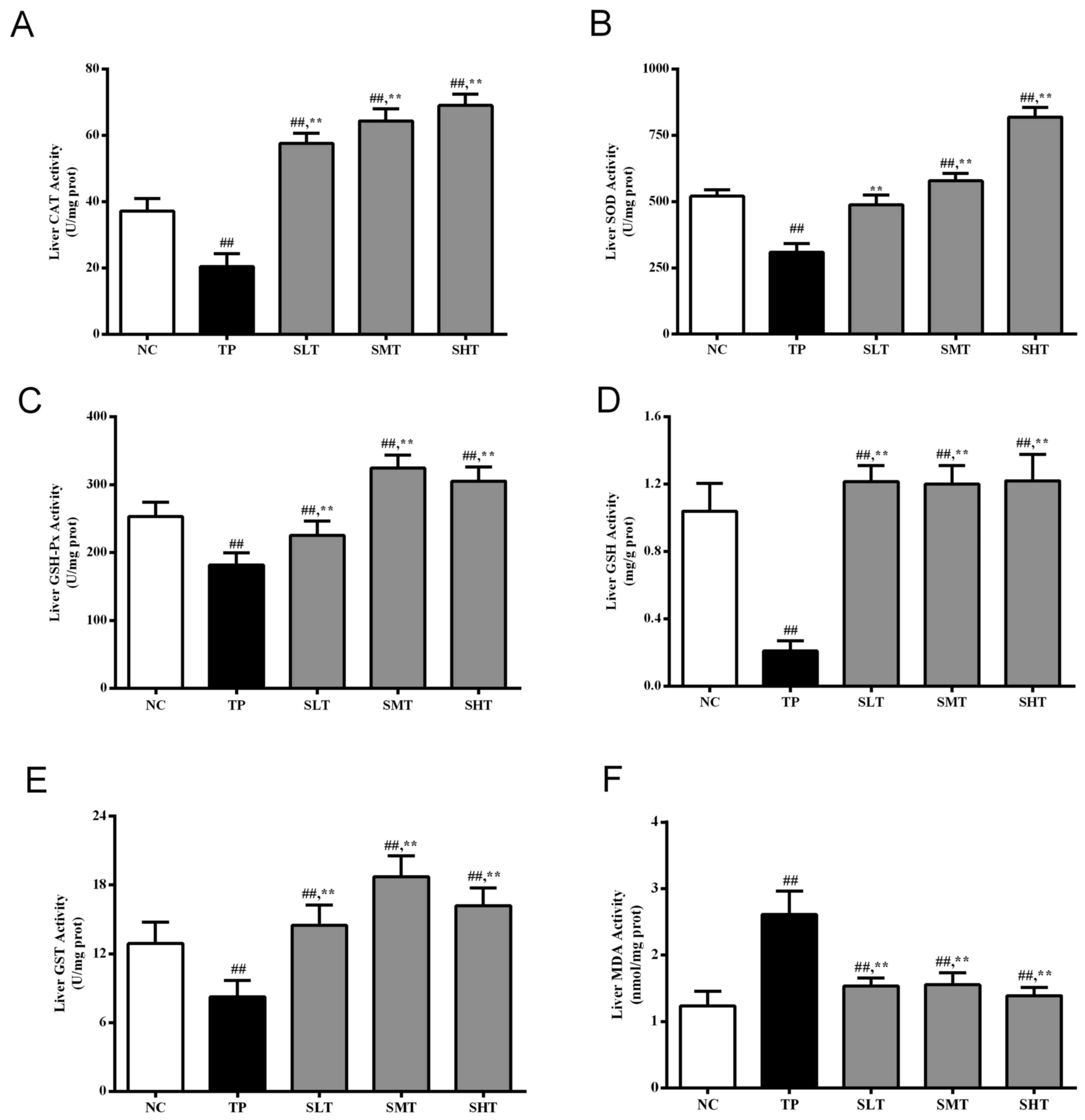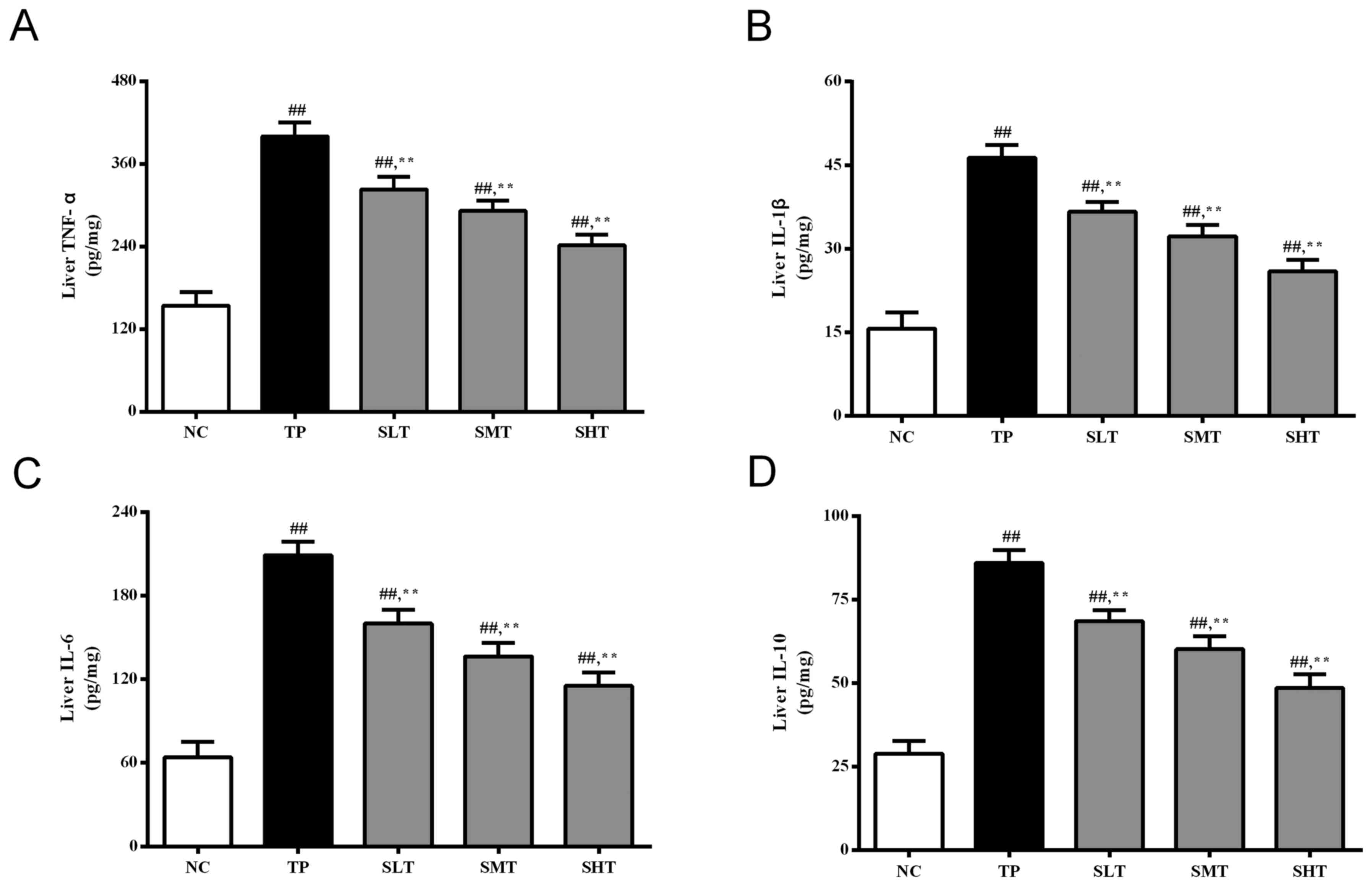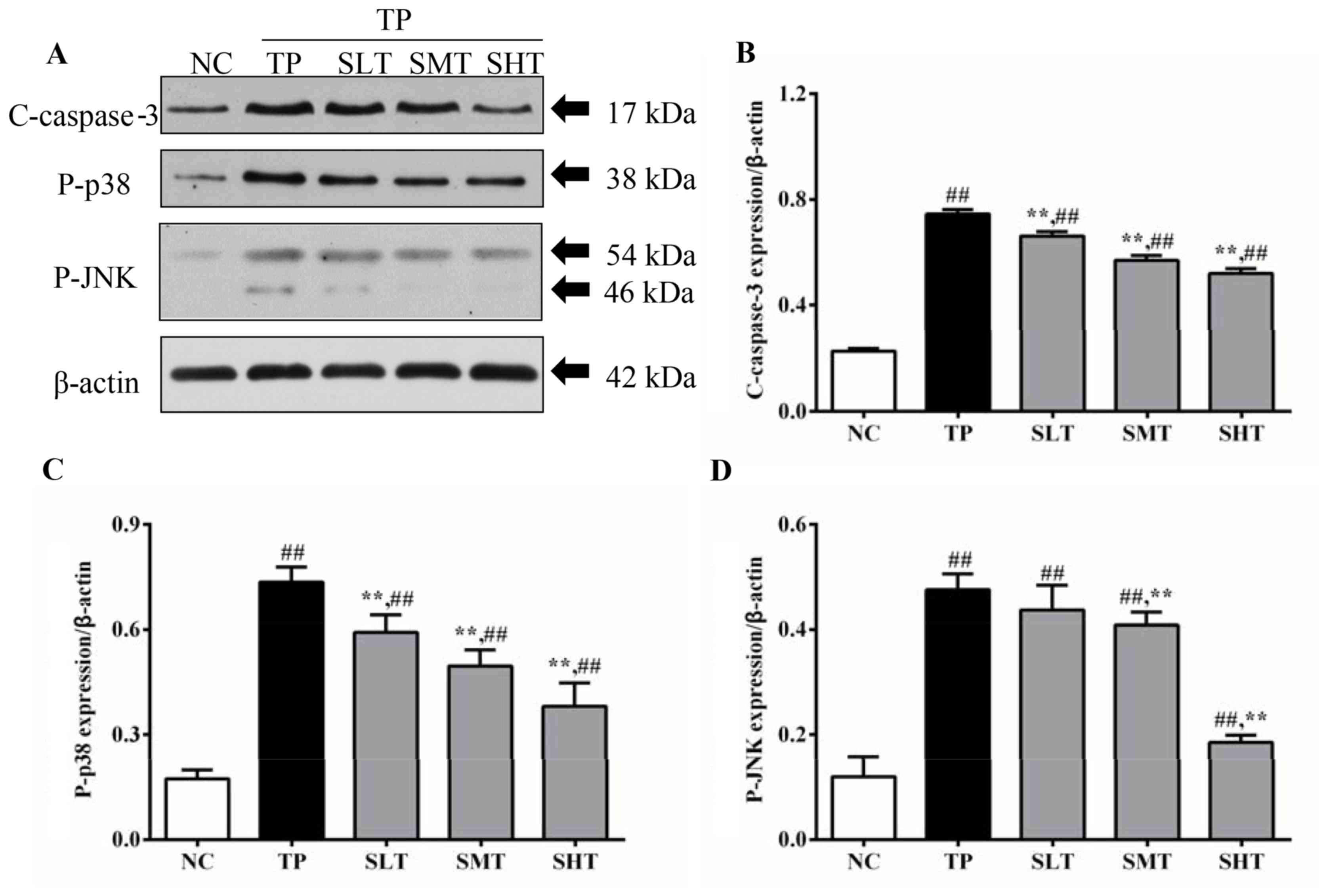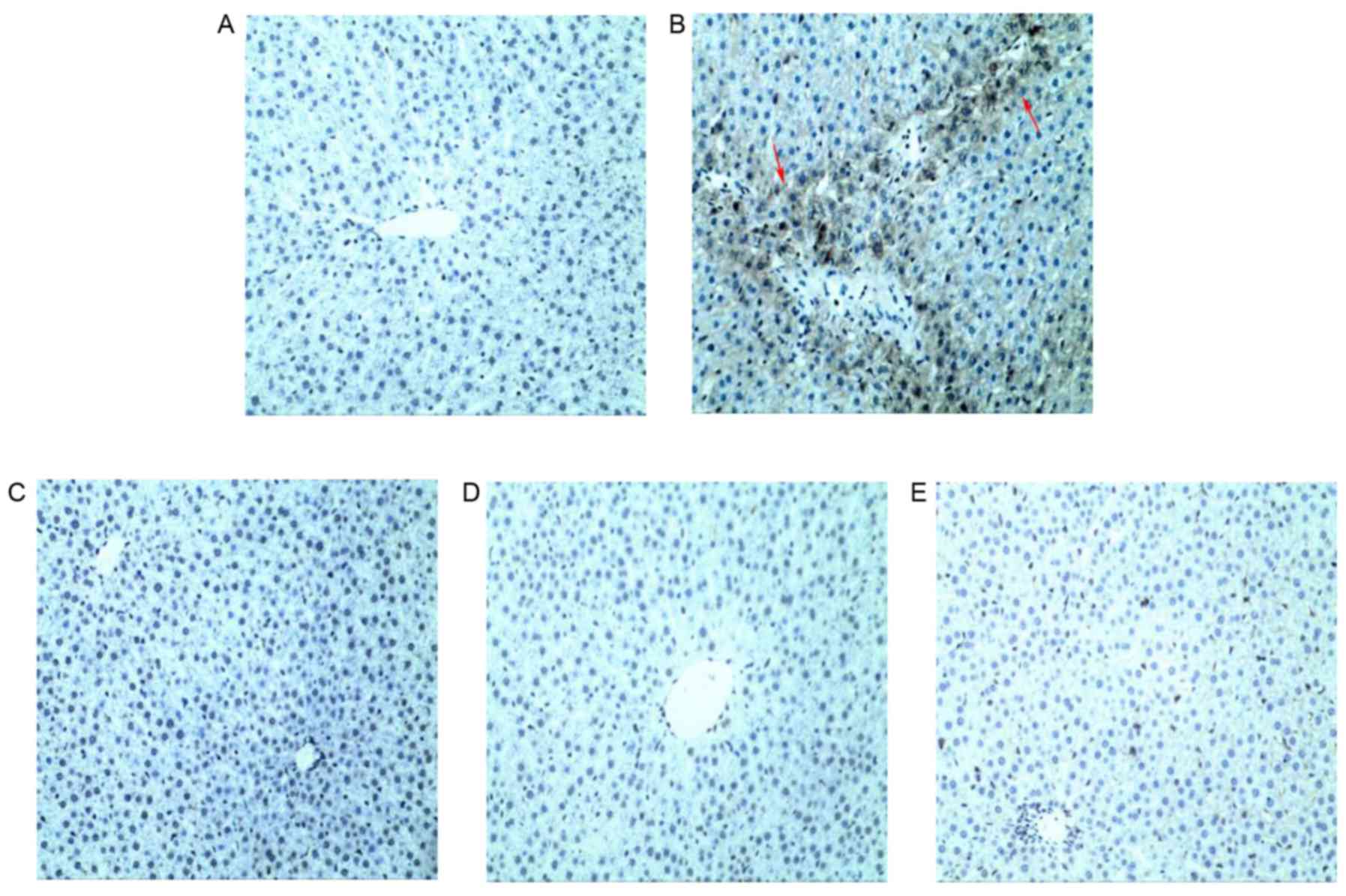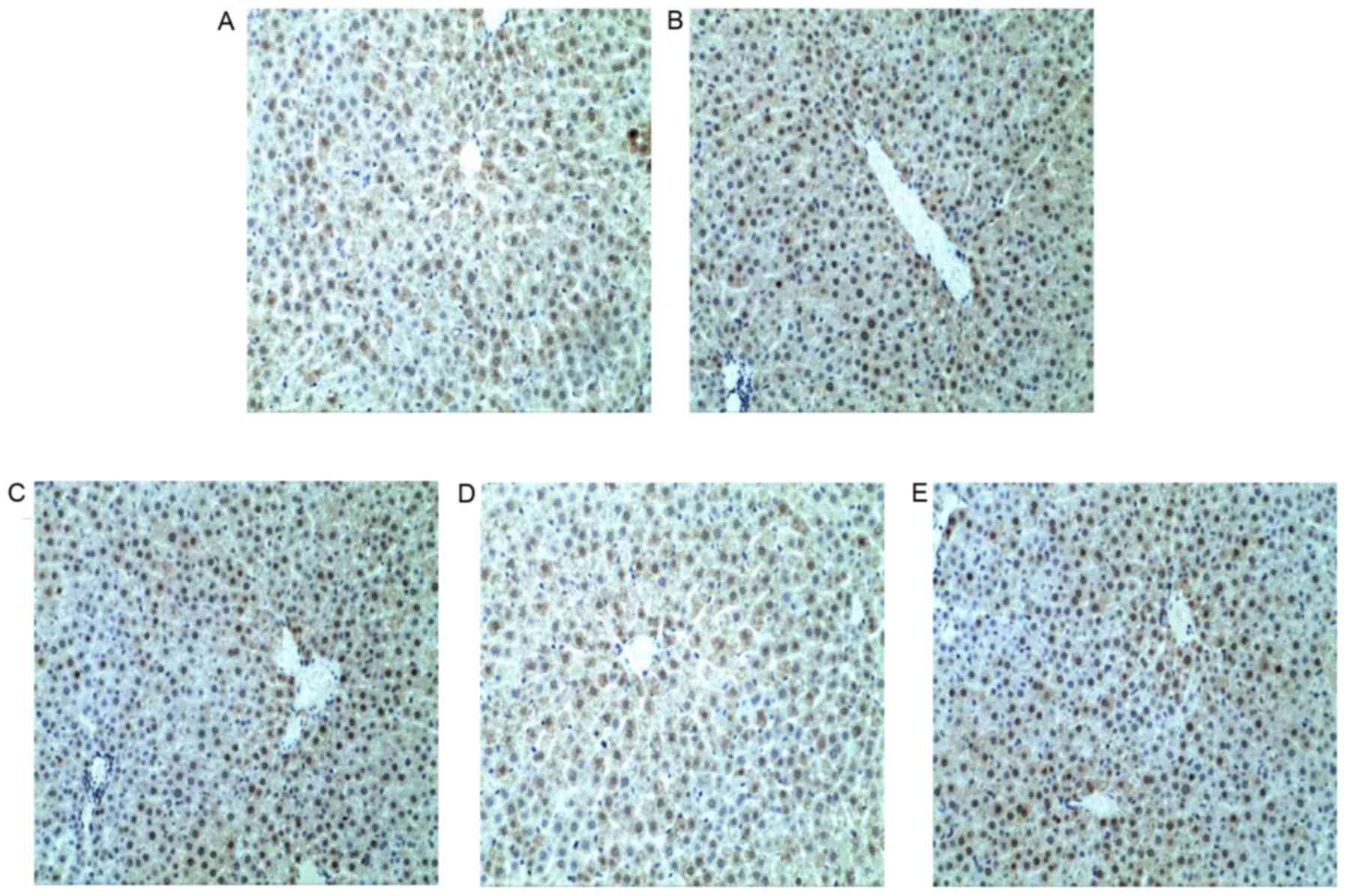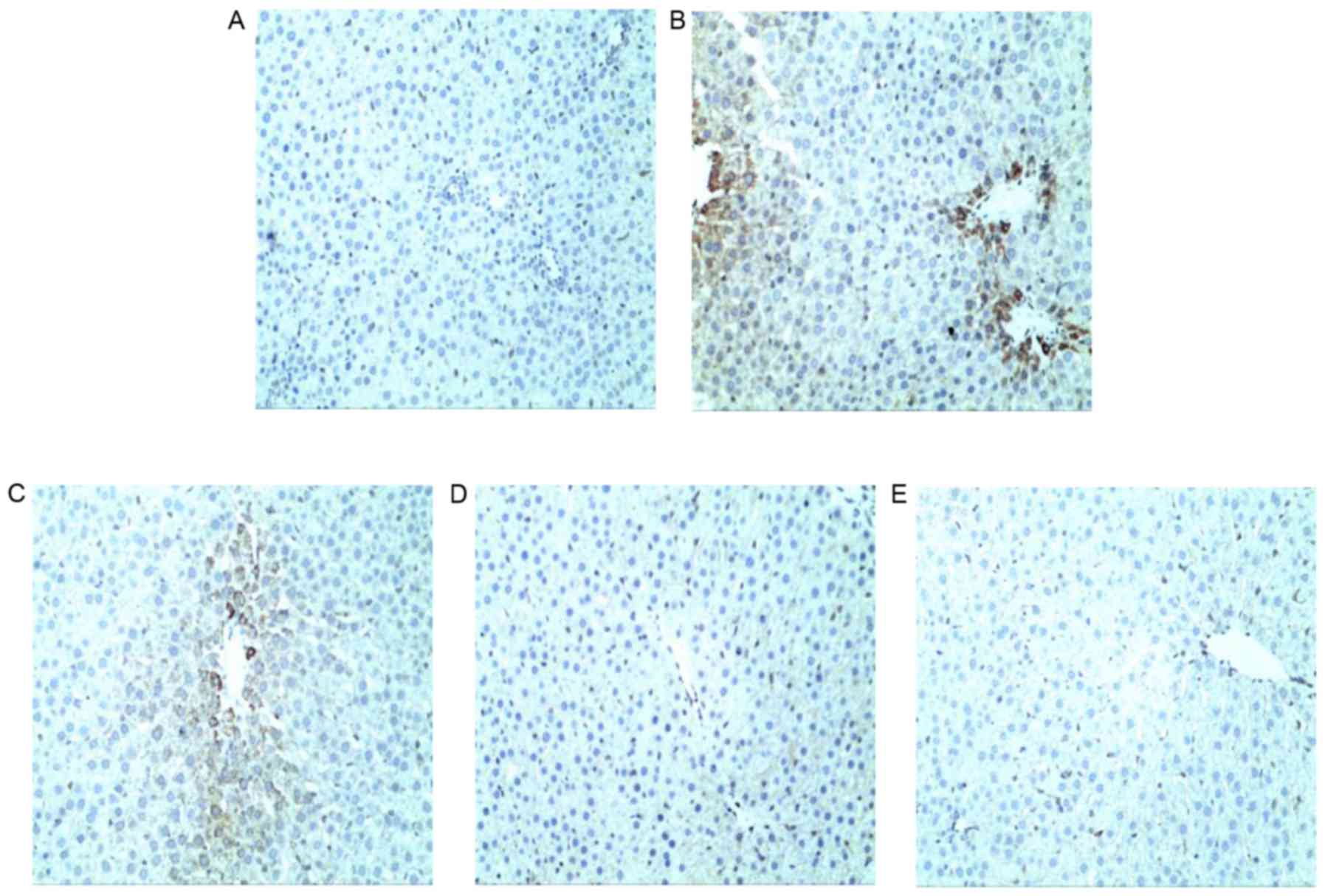|
1
|
Jia L, Feihai S, Cuiwen G, Wenwen W,
Xiaozhe S, Xinlu F, Min H, Jing J and Zhiying H: Activation of Nrf2
protects against triptolide-induced hepatotoxicity. PLoS One.
9:102014.
|
|
2
|
Chen BJ: Triptolide, a novel
immunosuppressive and anti-inflammatory agent purified from a
Chinese herb Tripterygium wilfordii Hook F. Leuk Lymphoma.
42:253–265. 2001. View Article : Google Scholar : PubMed/NCBI
|
|
3
|
Shu B, Duan W, Yao J, Huang J, Jiang Z and
Zhang L: Caspase 3 is involved in the apoptosis induced by
triptolide in HK-2 cells. Toxicol In Vitro. 23:598–602. 2009.
View Article : Google Scholar : PubMed/NCBI
|
|
4
|
Phillips PA, Dudeja V, McCarroll JA,
Borja-Cacho D, Dawra RK, Grizzle WE, Vickers SM and Saluja AK:
Triptolide induces pancreatic cancer cell death via inhibition of
heat shock protein 70. Cancer Res. 67:9407–9416. 2007. View Article : Google Scholar : PubMed/NCBI
|
|
5
|
Mei ZN, Lia XK, Wu QR and Yang XL: The
research on the anti-inflammatory activity and hepatotoxicity of
triptolide-loaded solid lipid nanoparticle. Pharmacol Res.
51:345–351. 2005. View Article : Google Scholar : PubMed/NCBI
|
|
6
|
Fu Q, Huang X, Shu B, Xue M, Zhang P, Wang
T, Liu L, Jiang Z and Zhang L: Inhibition of mitochondrial
respiratory chain is involved in triptolide-induced liver injury.
Fitoterapia. 82:1241–1248. 2011. View Article : Google Scholar : PubMed/NCBI
|
|
7
|
Yang J, Liu X..Bhalla K..Kim C.N..Ibrado
A.M..Cai J..Peng T.I..Jones D.P..Wang X.: Prevention of apoptosis
by Bcl-2: Release of Cytochrome c from mitochondria blocked.
Science. 275:1129–1132. 1997. View Article : Google Scholar : PubMed/NCBI
|
|
8
|
Newmeyer DD: Hot papers-apoptosis-the
release of cytochrome c from mitochondria: A primary site for Bcl-2
regulation of apoptosis by R.M. Kluck, E. Bossy-Wetzel, D.R. Green,
D.D. Newmeyer-Comments. Scientist. 13:16. 1999.
|
|
9
|
Shao LW, Huang LH, Yan S, Jin JD and Ren
SY: Cordycepin induces apoptosis in human liver cancer HepG2 cells
through extrinsic and intrinsic signaling pathways. Oncol Lett.
12:995–1000. 2016.PubMed/NCBI
|
|
10
|
Abenavoli L, Capasso R, Milic N and
Capasso F: Milk thistle in liver diseases: Past, present, future.
Phytother Res. 24:1423–1432. 2010. View
Article : Google Scholar : PubMed/NCBI
|
|
11
|
Pascual C, Gonz R, Armesto J and Muriel P:
Effect of silymarin and silybinin on oxygen radicals. Drug Devel
Res. 29:73–77. 1993. View Article : Google Scholar
|
|
12
|
Crocenzi FA and Roma MG: Silymarin as a
new hepatoprotective agent in experimental cholestasis: New
possibilities for an ancient medication. Curr Med Chem.
13:1055–1074. 2006. View Article : Google Scholar : PubMed/NCBI
|
|
13
|
Arafa HMM: Uroprotective effects of
curcumin in cyclophosphamide-induced haemorrhagic cystitis
paradigm. Basic Clin Pharmacol Toxicol. 104:393–399. 2009.
View Article : Google Scholar : PubMed/NCBI
|
|
14
|
Avci H, Tunca R, Epikmen E. T, Birincioğlu
SS, Sekkin SB Murat and Akşit H: Protective and antigenotoxic
effects of Silymarin and Curcumin in experimental cyclophosphamide
intoxication in rats. Kafkas Univ Vet Fak Derg. 22:693–701.
2016.
|
|
15
|
Schuppan D, Jia JD, Brinkhaus B and Hahn
EG: Herbal products for liver diseases: A therapeutic challenge for
the new millennium. Hepatology. 30:1099–1104. 1999. View Article : Google Scholar : PubMed/NCBI
|
|
16
|
Hahn G, Lehmann HD, Kurten M, Uebel H and
Vogel G: On the pharmacology and toxicology of silymarin, an
antihepatotoxic active principle from Silybum marianum (L.)
Gaertn. Arzneimittelforschung. 18:698–704. 1968.PubMed/NCBI
|
|
17
|
Rajasekaran A and Periyasamy M: Synthesis
and evaluation of hepatoprotective activity of some new mannich
bases bearing benztriazole moiety. J Chil Chem Soc. 55:366–370.
2010. View Article : Google Scholar
|
|
18
|
Jia R, Cao LP, Du JL, Xu P, Jeney G and
Yin GJ: The protective effect of silymarin on the carbon
tetrachloride (CCl4)-induced liver injury in common carp
(Cyprinus carpio). In Vitro Cell Dev Biol-Anim. 49:155–161.
2013. View Article : Google Scholar : PubMed/NCBI
|
|
19
|
Pappachan JM, Antonio FA, Edavalath M and
Mukherjee A: Non-alcoholic fatty liver disease: A diabetologist's
perspective. Endocrine. 45:344–353. 2014. View Article : Google Scholar : PubMed/NCBI
|
|
20
|
Voroneanu L, Nistor I, Dumea R, Apetrii M
and Covic A: Silymarin in type 2 diabetes mellitus: A systematic
review and meta-analysis of randomized controlled trials. J
Diabetes Res. 2016:51474682016. View Article : Google Scholar : PubMed/NCBI
|
|
21
|
Alcaraz-Contreras Y, Mendoza-Lozano RP,
Martínez-Alcaraz ER, Martínez-Alfaro M, Gallegos-Corona MA,
Ramírez-Morales MA and Vázquez-Guevara MA: Silymarin and
dimercaptosuccinic acid ameliorate lead-induced nephrotoxicity and
genotoxicity in rats. Hum Exp Toxicol. 35:398–403. 2016. View Article : Google Scholar : PubMed/NCBI
|
|
22
|
Kim SH, Oh DS, Oh JY, Son TG, Yuk DY and
Jung YS: Silymarin prevents restraint stress-induced acute liver
injury by ameliorating oxidative stress and reducing inflammatory
response. Molecules. 21:4432016. View Article : Google Scholar : PubMed/NCBI
|
|
23
|
Merrell MD and Cherrington NJ: Drug
metabolism alterations in nonalcoholic fatty liver disease. Drug
Metab Rev. 43:317–334. 2011. View Article : Google Scholar : PubMed/NCBI
|
|
24
|
Li XX, Du FY, Liu HX, Ji JB and Xing J:
Investigation of the active components in Tripterygium
wilfordii leading to its acute hepatotoxicty and
nephrotoxicity. J Ethnopharmacol. 162:238–243. 2015. View Article : Google Scholar : PubMed/NCBI
|
|
25
|
Li XJY, Jiang ZZ and Zhang LY: Triptolide:
Progress on research in pharmacodynamics and toxicology. J
Ethnopharmacol. 155:67–79. 2014. View Article : Google Scholar : PubMed/NCBI
|
|
26
|
Yang GH, Wang L, Yu XT and Chen H:
Protective effect of 18 beta-glycyrrhetinic acid against
triptolide-induced hepatotoxicity in rats. Evid Based Complement
Alternat Med. 2017:34703202017. View Article : Google Scholar : PubMed/NCBI
|
|
27
|
Dastagir G and Rizvi MA: Glycyrrhiza
glabra L. (Liquorice). Pak J Pharm Sci. 29:1727–1733.
2016.PubMed/NCBI
|
|
28
|
Adaramoye OA, Odunewu AO and Farombi EO:
Hepatoprotective effect of Curcuma longa L. in
D-galactosamine induced liver injury in mice: Evidence of
antioxidant activity. Afr J Med Med Sci. Suppl 39:S27–S34.
2010.
|
|
29
|
Wan JM, Sit WH, Lee CL, Fu KH and Chan DK:
Protection of lethal toxicity of endotoxin by Salvia
miltiorrhiza BUNGE is via reduction in tumor necrosis factor
alpha release and liver injury. Int Immunopharmacol. 6:750–758.
2006. View Article : Google Scholar : PubMed/NCBI
|
|
30
|
Wellington K and Jarvis B: Silymarin: A
review of its clinical properties in the management of hepatic
disorders. Biodrugs. 15:465–489. 2001. View Article : Google Scholar : PubMed/NCBI
|
|
31
|
Singh H, Sidhu S, Chopra K and Khan MU:
Hepatoprotective effect of trans-Chalcone on experimentally induced
hepatic injury in rats: Inhibition of hepatic inflammation and
fibrosis. Can J Physiol Pharmacol. 94:879–887. 2016. View Article : Google Scholar : PubMed/NCBI
|
|
32
|
Ali MHH, Messiha BAS and Abdel-Latif HAT:
Protective effect of ursodeoxycholic acid, resveratrol, and
N-acetylcysteine on nonalcoholic fatty liver disease in rats. Pharm
Biol. 54:1198–1208. 2016.PubMed/NCBI
|
|
33
|
Xing H, Jia K, He J, Shi C, Fang M, Song
L, Zhang P, Zhao Y, Fu J and Li S: Establishment of the Tree Shrew
as an alcohol-induced fatty liver model for the study of alcoholic
liver diseases. PLoS One. 10:122015. View Article : Google Scholar
|
|
34
|
Cao LJ, Li HD, Yan M, Li ZH, Gong H, Jiang
P, Deng Y, Fang PF and Zhang BK: The protective effects of
isoliquiritigenin and glycyrrhetinic acid against
triptolide-induced oxidative stress in HepG2 cells involve Nrf2
activation. Evid Based Complement Alternat Med. 2016:89121842016.
View Article : Google Scholar : PubMed/NCBI
|
|
35
|
Saller R, Meier R and Brignoli R: The use
of silymarin in the treatment of liver diseases. Drugs.
61:2035–2063. 2001. View Article : Google Scholar : PubMed/NCBI
|
|
36
|
Surai PF: Silymarin as a natural
antioxidant: An overview of the current evidence and perspectives.
Antioxidants (Basel). 4:204–247. 2015. View Article : Google Scholar : PubMed/NCBI
|
|
37
|
Feng B, Meng R, Huang B, Shen SM, Bi Y and
Zhu DL: Silymarin alleviates hepatic oxidative stress and protects
against metabolic disorders in high-fat diet-fed mice. Free Radic
Res. 50:314–327. 2016. View Article : Google Scholar : PubMed/NCBI
|
|
38
|
Zhang W, Hong RT and Tian TL: Silymarin's
protective effects and possible mechanisms on alcoholic fatty liver
for rats. Biomol Ther. 21:264–269. 2013. View Article : Google Scholar
|
|
39
|
Gu HP, Gu XZ, Xu QT and Kang WY:
Antioxidant activity in vitro and hepatoprotective effect of
Phlomis maximowiczii in vivo. Afr J Tradit Complement Altern
Med. 11:46–52. 2014. View Article : Google Scholar : PubMed/NCBI
|
|
40
|
Simeonova R, Vitcheva V, Kondeva-Burdina
M, Krasteva I, Manov V and Mitcheva M: Hepatoprotective and
antioxidant effects of saponarin, isolated from Gypsophila
trichotoma Wend. on paracetamol-induced liver damage in rats.
Biomed Res Int. 2013:7571262013. View Article : Google Scholar : PubMed/NCBI
|
|
41
|
Yuan L, Gu XZ, Yin ZH and Kang WY:
Antioxidant activities in vitro and hepatoprotective effects of
Nelumbo nucifera leaves in vivo. Afr J Tradit Complement Altern
Med. 11:85–91. 2014. View Article : Google Scholar : PubMed/NCBI
|
|
42
|
Farrell GC: Drugs and steatohepatitis.
Semin Liver Dis. 22:185–194. 2002. View Article : Google Scholar : PubMed/NCBI
|
|
43
|
Desplaces A, Choppin J, Vogel G and Trost
W: The effects of silymarin on experimental phalloidine poisoning.
Arzneimittel-Forschung. 25:89–96. 1975.PubMed/NCBI
|
|
44
|
Woo K, Stewart SG, Kong GS,
Finch-Edmondson ML, Dwyer BJ, Yeung SY, Abraham LJ, Kampmann SS,
Diepeveen LA, Passman AM, et al: Identification of a thalidomide
derivative that selectively targets tumorigenic liver progenitor
cells and comparing its effects with lenalidomide and sorafenib.
Eur J Med Chem. 120:275–283. 2016. View Article : Google Scholar : PubMed/NCBI
|
|
45
|
Imanishi H, Scales WE and Campbell DA:
Tumor necrosis factor alpha alters the cytotoxic effect of hydrogen
peroxide in cultured hepatocytes. Biochem Biophys Res Commun.
230:120–124. 1997. View Article : Google Scholar : PubMed/NCBI
|
|
46
|
Auguet T, Vidal F, López-Dupla M, Broch M,
Gutiérrez C, Olona M, Oltra C, Aguilar C, González E, Quer JC, et
al: A study on the TNF-alpha system in Caucasian Spanish patients
with alcoholic liver disease. Drug Alcohol Depend. 92:91–99. 2008.
View Article : Google Scholar : PubMed/NCBI
|
|
47
|
Kim EK and Choi EJ: Pathological roles of
MAPK signaling pathways in human diseases. Biochim Biophys Acta.
1802:396–405. 2010. View Article : Google Scholar : PubMed/NCBI
|
|
48
|
Herlaar E and Brown Z: p38 MAPK signalling
cascades in inflammatory disease. Mol Med Today. 5:439–447. 1999.
View Article : Google Scholar : PubMed/NCBI
|
|
49
|
Jaeschke H: Reactive oxygen and mechanisms
of inflammatory liver injury: Present concepts. J Gastroenterol
Hepatol. 26:173–179. 2011. View Article : Google Scholar : PubMed/NCBI
|
|
50
|
Jin YW, Zhao X, Zhang H, Li QS, Lu GD and
Zhao XG: Modulatory effect of silymarin on pulmonary vascular
dysfunction through HIF-1 alpha-iNOS following rat lung
ischemia-reperfusion injury. Exp Ther Med. 12:1135–1140. 2016.
View Article : Google Scholar : PubMed/NCBI
|
|
51
|
Zholobenko A and Modriansky M: Silymarin
and its constituents in cardiac preconditioning. Fitoterapia.
97:122–132. 2014. View Article : Google Scholar : PubMed/NCBI
|
|
52
|
Volbracht C, Leist M, Kolb SA and Nicotera
P: Apoptosis in caspase-inhibited neurons. Mol Med. 7:36–48.
2001.PubMed/NCBI
|
|
53
|
Wu D and Cederbaum AI: Oxidative stress
and alcoholic liver disease. Semin Liver Dis. 29:141–154. 2009.
View Article : Google Scholar : PubMed/NCBI
|
|
54
|
Kuwana T and Newmeyer DD: Bcl-2-family
proteins and the role of mitochondria in apoptosis. Curr Opin Cell
Biol. 15:691–699. 2003. View Article : Google Scholar : PubMed/NCBI
|
|
55
|
Yang F, Zhuo L, Ananda S, Sun TY, Li SX
and Liu L: Role of reactive oxygen species in triptolide-induced
apoptosis of renal tubular cells and renal injury in rats. J
Huazhong Univ Sci Technolog Med Sci. 31:335–341. 2011. View Article : Google Scholar : PubMed/NCBI
|
|
56
|
Tai T, Huang X, Su YW, Ji J, Su Y, Jiang Z
and Zhang L: Glycyrrhizin accelerates the metabolism of triptolide
through induction of CYP3A in rats. J Ethnopharmacol. 152:358–363.
2014. View Article : Google Scholar : PubMed/NCBI
|
|
57
|
Han FM, Peng ZH, Wang JJ and Chen Y: In
vivo effect of triptolide combined with glycyrrhetinic acid on rat
cytochrome P450 enzymes. Yao Xue Xue Bao. 48:1136–1141.
2013.PubMed/NCBI
|
|
58
|
Ye X, Li W, Yan Y, Mao C, Cai R, Xu H and
Yang X: Effects of cytochrome P4503A inducer dexamethasone on the
metabolism and toxicity of triptolide in rat. Toxicol Lett.
192:212–220. 2010. View Article : Google Scholar : PubMed/NCBI
|



